Risk factor
Defining level
Abdominal obesity, given as waist circumference
Men
>102 cm (>40 in.)
Women
>88 cm (>35 in.)
Triglycerides
≥150 mg/dL
HDL cholesterol
Men
<40 mg/dL
Women
<50 mg/dL
Blood pressure
≥130/≥85 mmHg
Fasting glucose
≥110 mg/dL
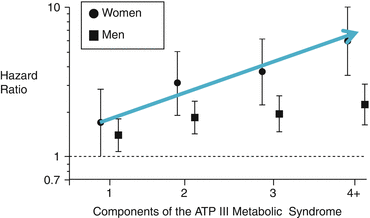
Fig. 13.1
Hazard ratios for cardiovascular disease according to gender and number of components of the MBS in the Atherosclesosis Risk in Communities (ARIC) study.
There have been a number of definitions of the metabolic syndrome since first described by Reaven in 1988 [10]. The metabolic syndrome was termed then “Syndrome X” after dyslipidemia, hypertension, and hyperglycemia were found to be strongly associated with development of overt diabetes and future cardiovascular disease. Due to the high prevalence of relative insulin resistance observed in these individuals, the term ‘Insulin Resistance Syndrome’ emerged, which was then followed by the term ‘metabolic syndrome’ now commonly adopted. The definition most widely used in studies and clinical practice is one recommended by the ATP III [6] where the syndrome is defined by having at least three of the following (Table 13.1):
Abdominal obesity (>40 in. (102 cm) in men or >35 in. (88 cm) in women)
High triglycerides (≥150 mg/dl)
Low HDL cholesterol (<40 mg/dl in men or <50 mg/dl in women)
Elevated blood pressure (≥130/85 mmHg)
Impaired fasting plasma glucose (≥110 mg/dl)
In addition to the development of cardiovascular disease and diabetes, the metabolic syndrome is associated with polycystic ovarian syndrome, hepatosteatosis, asthma, cholesterol gallstones, and some cancers [11].
It is well-documented that the metabolic syndrome affects women of ethnic minority groups disproportionately. Caucasian men and women seemingly have nearly the same rates, whereas within African Americans, women have a 57 % higher prevalence than African American men and within Mexican Americans women have a 26 % higher prevalence than Mexican-American men (Fig. 13.2) [12]. Independent of ethnicity, it appears that the prevalence of metabolic syndrome is increasing more in women than in men [6]. According to the National Health and Nutrition Examination Survey data from 1988 to 1994 compared to data from 1999 to 2000, the age-adjusted prevalence in metabolic syndrome in women increased by nearly 24 % compared to 2 % in men [7, 12]. The increased prevalence of metabolic syndrome in women is thought to be due to their increasing rates of hypertension, central obesity and elevated triglycerides. These individual risk factors and components of metabolic syndrome appear to be increasing in higher rates in women compared to men [7, 12–14]. Increased waist circumference, independent of BMI, increases the risk of developing metabolic syndrome in women more than men. In the San Antonio Heart Study participants with a BMI ≥30 kg/m2 versus those with a BMI < 25 kg/m2, men had an odds ratio of developing metabolic syndrome of 3.7 compared to 8.3 in women [8]. With higher waist circumference the findings are similar. For waist circumferences greater than 102 cm in men or greater than 88 cm in women the odds ratio for developing metabolic syndrome in men was 2.8 and much higher at 5.9 in women [7, 8]. Several meta-analysis have shown increased rates of cardiovascular events and death in both sexes with metabolic syndrome, with worsened hazard ratios in those studies done solely in women (see Figs. 13.3 and 13.4) [14].
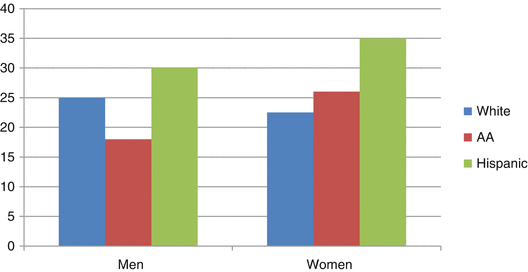
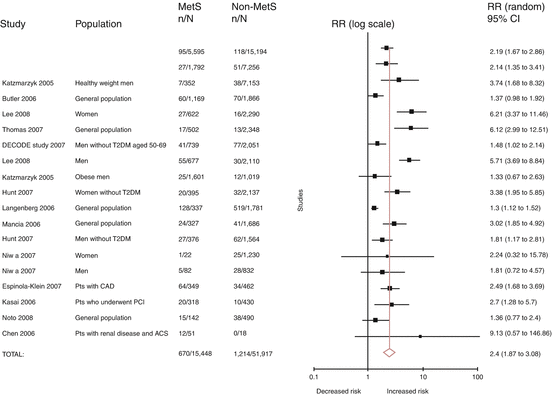
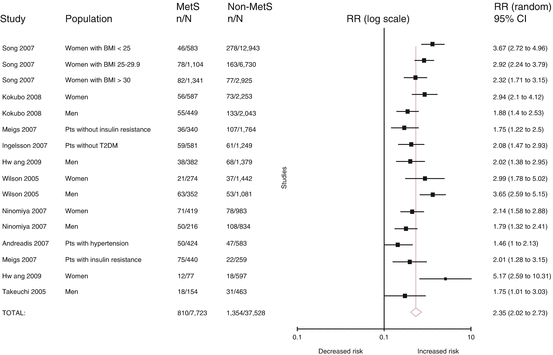

Fig. 13.2
Age-adjusted prevalence of metabolic syndrome among US adults by gender and race or ethnicity [12]

Fig. 13.3
Metabolic syndrome increases risk of cardiovascular disease in a meta-analysis 2.4 fold, with many of the studies above show worse hazard ratios for women (Reproduced with permission from Mottillo et al. [14])

Fig. 13.4
Metabolic syndrome increases risk of cardiovascular death 2.4 fold, with several studies showing higher hazard ratios in women (Reproduced with permission from Mottillo et al. [14])
The Silent Foe: Diabetes Mellitus in Women
Women in general are more likely to have diabetes than men [12]. It affects a higher total percentage of ethnic minority women in the United States with African-American women (12.6 %) and Mexican-American women (11.3 %) surpassing white women (4.7 %) in those over the age of 20.
According to the Third National Health and Nutrition Examination Survey (NHANES III, 1988–1994), the prevalence of diabetes in women, increases with age, doubling the amount of diabetes in women of middle age as compared to younger women [12, 13]. In fact, it was estimated at the time that nearly 2.7 million American women aged 40–59 had diabetes. Moreover, ethnic disparities that exist in the metabolic syndrome again ring true in diabetes. For women of middle age, diabetes is at least twice as common in ethnic minorities compared to Caucasian women. For example, according to the NHANES III data set for women ages 50–59, the prevalence of diabetes was 9.7 % for Caucasian women, 23 % for African American women, and 24 % for Mexican American women [12, 13]. No other national survey data exists for other ethnic groups regarding comparative trends unfortunately. Similarly, the death rate differences between these groups are more formidable. Between the ages of 45–64 the death rate in diabetic women was nearly three times more than that of non-diabetic women. But when death rates are examined by race, again ethnic differences among women become evident, with all-cause mortality rate in this age group being nearly doubled in African-American women 44.8 % compared to 26.9 % in Caucasian women despite control for cardiovascular risk factors [12, 13].
The original 1979 Framingham data provided interesting data regarding diabetic women. Initial data from this cohort showed diabetic women had similar cardiovascular disease risk as diabetic men. They were five times more likely than non-diabetic women and two times more likely than non-diabetic men to develop cardiovascular disease [2, 3]. Subsequent analyses have demonstrated that diabetic women also have significantly higher mortality than diabetic men, especially after a coronary event. Data shows that both, early and late, mortality after a myocardial infarction is significantly higher in diabetic women compared to diabetic men, with rates of 22 % versus 14 % and 28.9 % versus 19.6 %, respectively [2, 15, 16], (Fig. 13.5). The recent decreasing trend in cardiovascular mortality observed in men and in women without diabetes has not been seen in women with diabetes, who in fact have trended towards increased cardiovascular mortality, regardless of whether they were known diabetics or developed it after myocardial infarction [18]. Twenty year follow up data from the Nurses’ Health Study on approximately 1,700 female registered nurses, found impressive trends towards higher mortality in those women with diabetes. In that study women with diabetes were three times more likely to die of any cause than their non-diabetic colleagues. Furthermore, among women with known CAD at baseline, diabetic women were almost seven times more likely to die than nondiabetic women with CAD (Hazards Ratio 6.84). A very important observation in this study was the impact of length of exposure to diabetes. Duration of diabetes correlated with increased mortality risk, and demonstrated a 30-fold increased risk of fatal coronary heart disease in women with CAD and with diabetes of greater than 25 years [19].
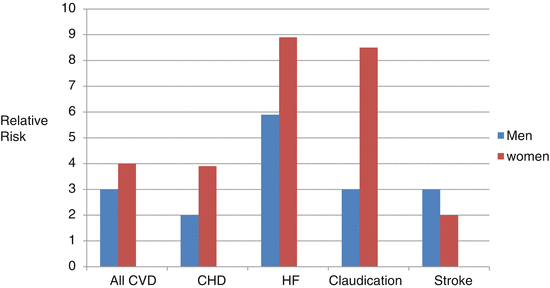

Fig. 13.5
Relative risk of cardiovascular events in patients with diabetes. (Ages 35–64) (Framingham Heart Study 30 year follow-up). P < 0.001 for all values except *P < 0.05 (Adapted by Velarde from Wilson and Kannel [17])
Practical Points in Diagnosis and Treatment
Diagnosis of Diabetes
The diagnosis of diabetes mellitus is rendered in the same way for both genders. Type 2 diabetes has a more insidious onset than type 1. Patients can typically escape formal diagnosis due to lack of overt symptoms early on and which usually occur years later. Type 2 diabetes has a complex genetic linkage which is stronger than for type 1 diabetes mellitus. It is often diagnosed more in women with hypertension and hyperlipidemia, thus causing additive or multiplicative effects in increasing CV risk.
Table 13.2 reviews the diagnostic criteria and evaluation for diabetes as recommended by the American Diabetes Association [21]
Table 13.2
Criteria for the diagnosis of diabetes
1. A1C ≥6.5 %. The test should be performed in a laboratory using a method that is NGSP certified and standardized to the DCCT assaya |
OR |
2. FPG ≥126 mg/dl (7.0 mmol/l). Fasting is defined as no caloric intake for at least 8 ha |
OR |
3. 2-h plasma glucose ≥200 mg/dl (11.1 mmol/l) during an OGTT. The test should be performed as described by the World Health Organization, using a glucose load containing the equivalent of 75 g anhydrous glucose dissolved in watera |
OR |
4. In a patient with classic symptoms of hyperglycemia or hyperglycemic crisis, a random plasma glucose ≥200 mg/dl (11.1 mmol/l) |
Gestational diabetes, a slightly separate entity, is defined as any degree of glucose intolerance during pregnancy, with most cases resolving after delivery. Currently mothers with the standard criteria for diabetes, as seen in Tables 13.2 and 13.3, are diagnosed with formal diabetes mellitus and not just gestational diabetes. To diagnose gestational diabetes an oral glucose tolerance test is administered between weeks 24 and 28 of gestation. Defined cut-offs exist for fasting, 1 and 2 h plasma glucose levels as stated on Table 13.3. Gestational diabetes in itself confers up to a 30 % increased risk of future development of adult onset diabetes, thus recommendations of post-delivery screening in the mother at least once every 3 years. Of importance is the addition of considering gestational diabetes (along with other pregnancy related complications) as a contributing risk factor for CVD in the revised American Heart Association guidelines of 2011 [22] stressing the importance of early assessment and diagnosis of life-time risk.
Table 13.3
Definitions, terms, classifications
Disorder/syndrome | Definition/criteria for diagnosis |
|---|---|
Metabolic syndrome | A group of risk factors when associated together predict future risk for cardiovascular disease and diabetes. Consist of 3 of 5 of the following: |
1. Abdominal obesity >102 cm (>40 in) in men, >88 cm (>35 in) in women | |
2. Triglycerides ≥150 mg/dL | |
3. HDL cholesterol <40 mg/dL in men, <50 mg/dL in women | |
4. Blood pressure ≥130/85 mmHg | |
5. Fasting glucose ≥110 mg/dL | |
Prediabetes | Glucose intolerance as defined by the presence of: |
1. Fasting plasma glucose 100 | |
2. Oral glucose tolerance test 140 | |
3. HgA1C 5.7 | |
Diabetes mellitus type 1 | Diabetes with hyperglycemia that results from a lack of insulin from the autoimmune destruction of beta-islet pancreatic cells |
Diabetes mellitus type 2 | Diabetes where there is primary insulin resistance and secondary progressive insulin secretory deficiency. Diagnosed with either: |
1. Fasting plasma glucose ≥126 mg/dL on more than one occasion | |
2. 75-g oral glucose tolerance test with 2 h value of ≥200 mg/dL | |
3. Random plasma glucose of ≥200 mg/dL with typical diabetes symptomsa | |
4. HgA1C ≥6.5 % | |
Gestational diabetes | Diabetes diagnosed during pregnancy that is not clearly overt new onset diabetes currently or known diabetes. Diagnosed by: |
1. 75-g oral glucose tolerance test at 24–28 gestation with | |
(a) Fasting glucose ≥92 mg/dL | |
(b) 1 h glucose ≥180 mg/dL | |
(c) 2 h glucose ≥153 mg/dL | |
Polycystic ovarian syndrome (PCOS) | Oligo or anovulation with signs of androgen excess activity (either clinically or by bioassay), polycystic ovaries, and exclusion of other causes |
Treatment of Diabetes and the Metabolic Syndrome
The American Diabetic Association endorses aggressive treatment of those with A1C levels within the abnormal range of 6–6.4 % with lifestyle modifications. These include, weight loss, diet and exercise as they are more than ten times at risk for developing diabetes than their normal A1C counterparts.
After the diagnoses of the metabolic syndrome, prediabetes or diabetes mellitus are made; care must be taken to meet therapeutic goals of glycosylated hemoglobin levels (HgA1C levels), blood pressure, cholesterol, and most importantly weight. Treatment of the metabolic syndrome consists primarily on emphasizing therapeutic lifestyle changes and in some instances may include medical treatment of prehypertension and or prediabetes, although guidelines are not clear on that. Women diagnosed with prediabetes or diabetes should be counseled on weight loss to a normal BMI if obesity is present, on a lean, low-fat diet, and recommended at least 30 min of cardiovascular exercise daily.
Glycosylated hemoglobin A1C (HgA1C) levels of less than or equal to 7 % should be attained through a combination of, diet, exercise, weight loss and medication.
Evidence supports aggressive lifestyle modification that promotes healthy diet and exercise as key parts of the treatment. Initial observational studies and small clinical trials suggested diet and exercise could curtail the development of diabetes. These studies were helpful and provided initial insight. The Diabetes Prevention Program (DPP) study was however the first sentinel trial to establish that weight loss and exercise can significantly reduce the development of diabetes.
Diabetes Prevention Program Study
The Diabetes Prevention Program Research Group was the first large cohort, with over 3,000 Americans, 68 % of which were women and 45 % of ethnic minority groups, that provided impressive evidence of decreased incidence of diabetes with weight loss and exercise in patients with impaired glucose levels (an elevated fasting plasma glucose or elevated post-load plasma glucose) that were not yet diabetic. When randomized to at least a 7 % weight loss and at least 150 min of physical activity a week, patients reduced their incidence of diabetes mellitus 58 % (95 % CI, 48–66 %) in a mean follow up of 2.8 years. Treatment with metformin reduced the incidence of diabetes as well, but only by 31 % (95 % CI, 17–43 %). There was no treatment difference between either sex nor were there differences between ethnic groups [23]. The results of the Diabetes Prevention Program empower health care providers to clearly and strongly advocate for weight loss, exercise, and healthy eating habits as a way to significantly reduce the risk of developing diabetes even more effectively than medications. Figuratively, to prevent a single case of diabetes during 3 years, 6.9 patients would have to commit to the above lifestyle intervention, while 13.9 would have to be placed on metformin.
Treatment of Hypertension in Diabetes
The most recent blood pressure goals have been established by The Seventh Report of the Joint National Committee on Prevention, Evaluation, and treatment of High Blood Pressure (JNC-7) and currently include a blood pressure of ≤130/80 and treatment with an angiotensin converting enzyme (ACE) inhibitor or angiotensin receptor blocker (ARB) as first line in those with diabetes due to their cardiac and renal protective effects. In women of child-bearing age, care must be taken to ensure that they are on oral contraceptives or similar birth control while on ACE inhibitors or ARBs to avoid adverse fetal effects. Nonetheless, they are both considered first line therapy for hypertension in diabetics of both sexes, with benefits shown both in cardiovascular outcomes and associated microvascular outcomes, including retinopathy, nephropathy, and neuropathy. There have been several important landmark clinical trials that have delineated the treatment algorithm for hypertension (Table 13.4). Although none of them directly studied hypertension solely in diabetic women, there were significant numbers of women enrolled in of these trials [24].
Table 13.4
Clinical trials of BP medications in patients with diabetes
Study | n | Follow up period (years) | Blood pressure (mmHg) | Drugs tested | Impact on outcomes |
|---|---|---|---|---|---|
UKPDS | 5,102 | 20 | Tight goal 150/85 versus less stringent goal <180/105 | Tight: captopril or atenolol | Favors tight control: decreased death from diabetes, stroke, and microvascular disease (retinopathy) |
HOT | 18,790 | 3.8 | Diastolic goal <80 versus ≤90 | Calcium channel blocker plus others | ≤80 group: decreased major cardiovascular events |
HOPE, MICRO-HOPE | 9,297 (3,577 with diabetes) | 3.5 (4.5) | Mean BP for both groups 139/79 at baseline | Ramipril versus placebo | Ramipril group: decreased MI, stroke, cardiovascular death, all-cause mortality, nephropathy |
ALLHAT | 42,418 (13,101 with diabetes) | 4.9 | Mean BP 146/83 at baseline | Amlodipine versus lisinopril versus chlorthalidone | Chlorthalidone group: lower systolic BP than amlodipine or lisinopril; no difference for fatal/nonfatal MI; increased heart failure for amlodipine and lisinopril versus chlorthalidone |
ABCD | 470 | 5 | Diastolic goal: Intensive ≤75 versus moderate ≤80–89 | Nisoldipine versus enalapril | Intensive: decreased death; no difference for retinopathy or neuropathy; increased MI for nisoldipine versus enalapril; renal function stabilized with both drugs |
ACCORD BP | 4,733 | 4.7 | Systolic goal <120 versus <140 | Stepped care to reach goals | No difference in nonfatal MI, nonfatal stroke, or cardiovascular death |
UKPDS
Spanning from 1977 to 1997 and involving 23 centers, the United Kingdom Prospective Diabetes Study (UKPDS) had over 5,000 patients with a new diagnosis of diabetes and was the first hallmark study to show definitively that complications can be reduced by blood glucose and blood pressure control. The treatment arms consistent of a tight blood pressure group with goal of blood pressure 150/85 versus a less tight blood pressure control group with goal of blood pressure 180/105. Forty-six percent of the tight blood pressure group were women, 42 % of the less tight blood pressure group were women. Patients in the tight blood pressure group treated with captopril and atenolol had decreased risk of in the combined endpoint of myocardial infarction, sudden death, stroke, and peripheral vascular disease, with a relative risk of 0.66. Risk in primary retinopathy was also seen, but significant reduction in myocardial infarctions alone was not seen [24, 25]. Interestingly, the risk reductions were not significant 10 years after the trial as during the post-trial period patients were no longer on their intensive hypertensive regimen [26].
HOT Trial
The Hypertension Optimal Treatment study was important to establish the benefit in reduction in diastolic blood pressure. Approximately 47 % of those enrolled were women. A large randomized trial with over 18,000 patients between the ages of 50–80 years old, it used first-line treatment of felodipine with additional antihypertensives as needed. Results showed benefit in decreasing blood pressure to less than 140/85. Additionally, there was a remarkable 51 % reduction in cardiovascular events in diabetic patients with diastolic blood pressures ≤80 mmHg in comparison to diabetic patients with diastolic blood pressures ≤90 mmHg (p = 0.005) [24, 27].
< div class='tao-gold-member'>
Only gold members can continue reading. Log In or Register to continue
Stay updated, free articles. Join our Telegram channel

Full access? Get Clinical Tree


